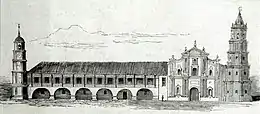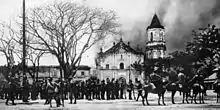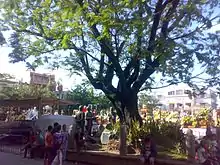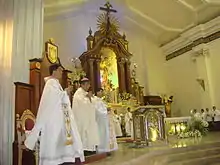Malolos Cathedral
The Malolos Cathedral, also known as the Minor Basilica of Our Lady of Immaculate Conception (Spanish: Basilica Menor de Nuestra Señora de la Inmaculada Concepción), is a historical church in the Philippines located in City of Malolos, the capital of the province of Bulacan. The cathedral is also the ecclesiastical seat of the Bishop of the Diocese of Malolos, a suffragan of the Archdiocese of Manila.
| Malolos Cathedral | |
|---|---|
| Minor Basilica of Our Lady of Immaculate Conception in Malolos Basílica Menor de Nuestra Señora de la Inmaculada Concepción de Malolos | |
.jpg.webp) Malolos Cathedral in Bulacan | |
.svg.png.webp) Malolos Cathedral Location in the Philippines | |
| 14°50′32″N 120°48′41″E | |
| Location | Malolos, Bulacan, |
| Country | |
| Denomination | Roman Catholic |
| History | |
| Former name(s) | Malolos Church and Convent |
| Status | Minor basilica |
| Founded | 11 June 1580 |
| Founder(s) | Matheo de Mendoza |
| Consecrated | 1817 |
| Past bishop(s) | Jose Oliveros |
| Architecture | |
| Functional status | Active |
| Heritage designation | Palacio Presidential |
| Designated | 1951 |
| Architect(s) | Roque Barrionuevo 1591, Don Luciano Oliver 1870 |
| Architectural type | Church |
| Style | Neoclassical |
| Groundbreaking | 1580–1591 |
| Completed | 1673, 1754, 1817 |
| Demolished | 1814 convent, 1903 convent |
| Specifications | |
| Capacity | 2,000 |
| Number of domes | 1 |
| Materials | Stone |
| Bells | 12 (8) |
| Administration | |
| Diocese | Roman Catholic Diocese of Malolos |
| District | Central District |
| Division | Western |
| Clergy | |
| Bishop(s) | Dennis Villarojo |
| Rector | Domingo Salonga |
| Chancellor | Cenon Dennis Santos |
| Priest(s) | Joseph Fidel Roura and Howard John Tarrayo |
Beginnings
Due to the defeat of the Hagonoy and Macabebe natives headed by Bambalito against Spanish conqueror Martin de Goiti and Juan Salcedo at the Battle of Bangkusay on June 3, 1571. The Spaniards pacified the northern villages of Manila. They arrived at the river banks of Malolos River on November 14, 1571 and conceded the unnamed eight villages into Encomienda of Malolos under Don Marcos de Herrera. On April 5, 1572 Legazpi aggregates the villages of Calumpit, Malolos, Bangkal (also in Malolos) Magong (now Paombong) were unified under a single Encomienda vis-a-vis Pueblo under the name of "Calumpit" administered jointly by Don Marcos de Herrera and Sargento Mayor Juan Moron[1]
Also in April 1572 the Augustinian Friars arrived at the bank of Meyto River headed by Fray Diego de Herrera but he was dispatched in Spain. On May 3, 1572 upon the election of the new Prior Provincial of the Augustinians, Fray Martin de Rada overtook the administration of Convento de Calumpit with Fray Diego Ordoñez de Vivar as his parochial vicar, a native of Guadalajara, Mexico established and accepted Calumpit wherein he Christianized and baptized the village of Meyto, Meysulao, Pandocot, and Calumpit. Vivar expanded the ecclesiastical missions to the villages of Malolos and Hagonoy. It is simplified to say that also on this period Malolos was annexed as one of the visitas and mission (sub-parishes) of the Calumpit in Bulacan Eight years later on June 11, 1580, Malolos Church was recognized as a separate town and parish having three visitas namely Paombong,Matimbo and Mambog with Fray Matheo de Mendoza OSA as its first Curate (Conquistas delas Islas Philipinas of Fr.Gaspar de San Agustin) while Binto 'y Quingua on the other hand according to Galende's Angeles in Stone, included later as its visita on May 21, 1599 but an earlier date appear according to a document on Report to the King of Spain made by Governor General Luis Perez Dasmariñas in June 1591 it appears Binto as visita under the instruction of the Malolos Convent. On January 3, 1582 the Augustinian council fathers authorized the provincial to grant the town of Malolos to have its voting power to the provincial chapters. The Catalogo of 1591 indicates Malolos had one convent with three thousand six hundred (3,600) souls. In 1599, San Agustin Monastery in Intramuros asked Malolos prior, Fray Roque de Barrionuevo to contribute an annual rent of fifteen pesos,twenty bushels of rice and sixty chickens.
Due to the frequent flooding of its first and second location, they moved the church to a higher location from time to time. The hermitage were initially built made of cogon and bamboo materials in early 1573 at the banks of Liang River. Transferred later on the site now called Bangkal (today San Agustin-Caingin area) and in 1578–1579 it was transferred to Mambog where the prominent tree named Kalumpang once stood. It became "Poblacion" in sometime in 1673 when the exact boundaries of the town was demarcated and configured. The town church made of light material where later enlarged in the year 1590 under the curacy of Fray Cristobal Tarique, OSA when Fray. Roque de Barrionuevo assigned to the town he brought a wooden image of Saint Roque,he started the construction of the bigger church in 1599 and at the same date he built the Chapel of Mambog.
The Estado of 1612 mention that Malolos convent had two (2) priest and two thousand and one hundred (2,100) souls. In year 1630, Fr. Mateo de Braceros started to build a church made of hewn stone and it was continuously built under the town friars throughout namely Fr. Agustin Carreno in 1635, Fr. Juan de Trezo in 1638, Fr.Andres Jimenez in 1639, in the same year Fr. Jimenez donated 2 bells weights 39 kilogram and 2- kilograms in Superior Gobierno in Intramuros for the campaign of Governor General Corcuerra against Muslims (Galende). Construction continued by Fr. Sandro Moncada, constructions are slightly interrupt due to Revolt of Don Pedro Ladia in 1640 at the term of Fr. Cristobal Enriquez. Succeeded by Fr.Lorenzo Figueroa continued construction from 1641 to 1653. It was nearly finished in 1669 under Fr. Francisco Martinez. In 1671, the church were almost done by the time of Fr. Ildefonso Tellez in 1672 and Fr. Jaime Balzac (restored as Malolos curate) and Fr. Francisco Lopez applied the few finishing touches and the first ever stone church of Malolos was finished in 1673. In 1732 Malolos convent has four thousand four hundred ninety-one souls, in 1760 had seven thousand six-hundred twenty-four souls. The Intermediate Meeting of the Augustinians of 1763 was held in Malolos Convent establishing the Prior of Pulilan.
However, both the church and the convent were totally destroyed by fire in 1813.
Construction of the present church

The construction of the present church was started in 1814 and completely finished in 1817 under Fray. Melchor Fernández. An embossed stone marker was installed in the main portal of the church depicting ANOD1817. It was consecrated by Ilmo. Francisco Albán, Bishop of Nueva Segovia (Vigan) on October 18, 1826, the only stone church consecrated in the archiphelago at that time. Fray Fernandez also a prolific builder was also responsible for the addition of arches to the convent; the fortification of the belfry to accommodate the installation of a clock; and the construction of the stone bridge connecting Malolos with Barasoain. However, the convent were destroyed and the main church with minor damages by a strong earthquake in 1863. Fray. Ezekiel Merino and Don Luciano Oliver, a prominent Manila architect at that time undertook the reconstruction of the interior and collapsed structures which lasted until 1872.[2]
Another severe earthquake took place in 1880 which destroyed the convent. Fray Juan Tombo began the restoration of the convent in 1883. It was completed in 1884 by Fray Felipe Garcia.[2]
The convent as the presidential palace
The Malolos Cathedral convent served as the presidential palace of Emilio Aguinaldo, during the First Philippine Republic from September 15, 1898 to March 31, 1899. Aguinaldo used the convent as his office.
During the Philippine–American War, the US Army decided to strategize their "Northern Campaign" by moving the US soldiers forward to Malolos in order to defeat the Filipino forces in town. Aguinaldo and his men decided to escape before the American Army arrived in the capital. While escaping to San Fernando, Pampanga, Aguinaldo ordered General Antonio Luna to burn down the Malolos Church, as part of his scorched earth policy so that anything left would be rendered useless.
Church rebuilding

From the ashes of war, the church was rebuilt from 1902 to 1936. Starting in the mid 20th-century major changes were made to the church beginning in the 1950s when the entrance to the church was made into three doors. Prior to this renovation, the structure had only one door at the center.
Under the curacy of Msgr. Pedro Abad, the baptistery was built and blessed by the Archbishop of Manila Rufino Cardinal Santos on February 28, 1954. The pews were acquired in 1957 by Msgr. Marcelino Montemayor and the roof was replaced during the time of Msgr. Francisco Domingo.
Elevation to a cathedral
The Malolos Church became a cathedral with the creation of the Diocese of Malolos and the installation of its first diocesan bishop, Most Reverend Manuel del Rosario D.D., in March 1962.
Other renovations
With the reforms of the Second Vatican Council, Msgr. Virgilio Soriano commissioned a new altar in 1967.
Another major renovation of the Cathedral happened in 1970. Prior to this renovation, the cathedral's bell tower was a topped with a triangular cone, as seen on the old picture taken mostly during the Philippine–American War from 1898–1899. In 1970, the triangular cone that previously topped the bell tower was removed and replaced by a concrete statue of the Immaculate Conception, donated by Amparo Bautista-Julian.
When the cathedral together with the new bishop palace was again consecrated by Papal Nuncio Bruno Torpigliani DD on December 4, 1976, the communion rail was dismantled and the sanctuary was renovated with stained glass windows. The old convent was reconstructed and expanded to accommodate the bishop's residence, chancery office and parish convent. During the incumbency of Msgr. Macario Manahan, the St. Joseph Social Hall was built; the old baptistery was transformed into a mortuary chapel; and a crypt was constructed below the main altar.
Elevation to a Minor Basilica
When Rolando Tria-Tirona O.C.D., DD became bishop and moderator of the Team Ministry, renovations and repairs were undertaken like the Diocesan Hall being refurbished into the Mary Magdalene Hall. It was under the tenure of Bishop Tirona that the cathedral was elevated into the Minor Basilica of the Immaculate Conception on December 4, 1999. The fourth bishop, Jose Oliveros, D.D. continued to make improvements especially with the church patio and its environs. The statues under the Kalayaan tree, the memorial cross fronting the Basilica and the Presidential Gate constituted different phases which are connected with the Patio Development Plan.
Style and design
The predominant feature of the Cathedral-Basilica is the semi-circular arch in its lower part. The ornamentation is moderate; the massing is well balanced and the symmetrical movement of the columns and openings are almost neoclassic. The facade is divided by single and coupled Doric columns in three segments, and is dominated by large semi-circular arches of the openings in the first level, and the smaller ones superimposed on the second level which are alternately semicircular and segmented. The triangular pediment strongly outlined by heavily projecting broken cornices is topped by a sort of acroteria in the center and torch-like finials. A statued niche flanked by fluted pilasters topped by a segmented canopy crowns the silted frame of the center window. Triglypha decorate the frieze and a stylized Augustinian emblem decorates the center of pediment. The over-all impression is one of the neatness of line, counterbalanced by the dramatic circular of the openings.
The image of the Immaculate Conception at the main altarpiece
According to reliable information, the statue of the Immaculate Concepcion was made before the Second World War. The work is attributed to Donding Ople, a gifted artist who was orphaned at a very tender age. The original work is kept in an undisclosed place but the statue at the high enclosure behind the main altar is the perfect replication of the original. Many of the devotees flock to the image of the Immaculate Concepcion.
The miraculous image of Our Lady of the Immaculate Conception
The miraculous image of Our Lady enshrined at the main altar was carved by a certain Donding Ople in 1950. Due to the miracles attributed in devotion to the Immaculate Conception, the Malolos curate decided to produce some replicas. An elite replica of the said statue was first displayed at the right of the Sanctuary, at the middle, and beside the statues of Saint Joachim at Saint Peter patriarch.
The devotion to Immaculate Conception seems to be very effective and so to enrich the faith of the Maloleños, a set of stairs was attached to the altar so the people may go and touch the statue. This action was made under the time of then rector, Msgr. Jojo Galvez with Fathers Ron Cristobal and Francis Protacio S. Cortez III as members. Also around this time, the statue was officially named "Virgen Inmaculada Concepcion de Malolos" (Our Virgin of Immaculate Conception of Malolos).
In their tenure, a replica of the image was placed in front of the Adoration Chapel's Capella Sanctorum (Chapel of the Saints). The statue is placed in the middle of the highest elevation and is connected down with a set of stairs. Next to the entrance stair is a "Prayer Requests" book where devotees write their prayers. Next to the exit stairs is the "Answered prayers" book where devotees were write their own experiences of divine intervention through the said statue.
The Canonical Coronation and the 50th Golden Jubilee
Due to popularity of miraculous attributes, a petition was made for the Canonical Coronation of the image at the main altar of Malolos Cathedral. In May 2009, the Vatican granted the petition for the canonical coronation through a papal bull. The Solemn Canonical Coronation held on March 10, 2012. During the time of Msgr. Jaime Garcia and Fr. Conrado "Badong" Santos, Jr. and Renato "R.J." Brion, [2009–present] renovations and refurbishments inside and outside the cathedral and its patio were started in preparation for the Canonical Coronation and the Golden Jubilee of the Diocese of Malolos. When Msgr. Jaime Garcia died on June 4, 2011, Fr. Pablo S. Legaspi, Jr. replaced him as rector, continuing and completing the needed refurbishments in preparation for the diocese's Golden Jubilee.

The Kalayaan Tree
The Kalayaan Tree (locally called Siar, a Yellow flame tree) is located at the patio of the cathedral. It is not certain that Aguinaldo planted this tree because it was already mature when the First Philippine Republic was established. The historical significance of this tree is that it is a living witness to the Malolos Republic. Aguinaldo and his Cabinet have conducted many political discussions there. Under the tree, a monument was placed symbolizing the meeting of Filipino revolutionaries, represented by Gen. Gregorio del Pilar and Gen. Isidoro Torres; Don Pablo Tecson, an erudite legislator; Padre Mariano Sevilla, a nationalist leader of the church and Doña Basilia Tantoco, portraying a woman freedom fighter.
 Interior of the Cathedral
Interior of the Cathedral The Cathedral Presbytery
The Cathedral Presbytery Lobby of the Diocesan Chancery
Lobby of the Diocesan Chancery The new cathedra at the side of the sanctuary
The new cathedra at the side of the sanctuary Image of Our Lady of Immaculate Conception of Malolos at the Chapel of the Saints
Image of Our Lady of Immaculate Conception of Malolos at the Chapel of the Saints
Parish priests 1580–1961
From 1580 up to the present time, Malolos Cathedral has a long list of parish priests who administered the church. The list includes priests from the Augustinian Order and from the Archdiocese of Manila. Due to the antiquity of Malolos Church, the list of parish priests from 1580 to 1680 came from the catalog of Augustinian Province archive.[3]
| Parish Priest | Year assigned |
|---|---|
| Fray Matheo de Mendoza OSA | 1580–1584 |
| Fray Diego Muñoz OSA | 1584–1585 |
| Fray Pedro Tristán OSA | 1585–1590 |
| Fray Cristobal Tarique OSA | 1590–1591 |
| Fray Francisco Bustos OSA | 1591–1600 |
| Fray Andres Ibarra OSA | 1600 |
| Fray Roque de Barrionuevo OSA | 1600–1605 |
| Fray Juan de Valderrama OSA | 1605–1609 |
| Fray Francisco de Castramonte OSA | 1609–1611 |
| Fray Antonio Marquéz de Figueroa OSA | 1611–1614 |
| Fray Fernando de Santa María Trujillo OSA | 1614–1618 |
| Fray Pedro de Salcedo OSA | 1618–1623 |
| Fray Diego Robles OSA | 1623–1626 |
| Fray Mateo de Braceros OSA | 1626–1635 |
| Fray Agustin Carreno OSA | 1635–1636 |
| Fray Juan de Trezo OSA | 1636–1639 |
| Fray Andres Jiménez OSA | 1639–1641 |
| Fray Sandro Moncada OSA | 1641–1650 |
| Fray Cristobal Enriquez OSA | 1641–1653 |
| Fray Lorenzo Figueroa OSA | 1653 |
| Fray Jeronimo Ramos OSA | 1653–1656 |
| Fray José de Mendoza OSA | 1657–1659 |
| Fray Diego Arellano OSA | 1659–1662 |
| Fray Jerónimo de León OSA | 1662–1665 |
| Fray Diego Gutíerrez de la Fuente OSA | 1665–1669 |
| Fray Francisco Martínez OSA | 1669–1671 |
| Fray Jaime Balzac OSA | 1671–1674 |
| Fray Ildefonzo Téllez OSA | 1674 |
| Fray Diego Alday OSA | 1675 |
| Fray Jaime Balzac OSA | 1677–1680 |
| Fray Juan de San Nicolás OSA | 1680 |
The list below is from the Malolos Cathedral Archive. Note that the Malolos Church was burned down in 1899, and records are incomplete. Malolos Cathedral recorded the list of priests only from 1673.
| Parish Priest | Term |
|---|---|
| Fray Francisco López OSA | 1673–1734 |
| Fr. Yniguez OSA | 1734–1736 |
| Fray Manuel Cortezar OSA | 1740–1741 |
| Fray Josef de Viaz OSA | 1742–1743 |
| Fray Manuel Sacus de Nicolás OSA | 1744 |
| Fray Josef de Victoria OSA | 1745 |
| Fray Bernardo de San Guillermo OSA | 1746 |
| Fray José de León OSA | 1749 |
| Fray Manuel Cortezar OSA | 1750–1752 |
| Fray Josef de Viaz OSA | 1753–1755 |
| Fray José Montero OSA | 1756 |
| Fray Domingo Deovides OSA | 1757 |
| Fray Gregorio Gener OSA | 1758 |
| Fray Biaz Aguirre OSA | 1759 |
| Fray José Mediavilla OSA | 1760 |
| Fray Antonio Miranda OSA | 1760–1768 |
| Fray Manuel Ortega OSA | 1768 |
| Fray Pedro Cordojuela OSA | 1769–1770 |
| Fray Diego Pérez OSA | 1770 |
| Fray Matiaz Nubia OSA | 1771 |
| Fray Antonio de San Prospero OSA | 1772–1774 |
| Fray Carlos Manrivero OSA | 1774 |
| Fray Joaquín Maturana OSA | 1775–1801 |
| Fray Benito Santillán OSA | 1801-1800 |
| Fray Juan Crespo OSA | 1801–1802 |
| Fray Andres Vigil OSA | 1802 |
| Fray Dionisio Santa María OSA | 1803–1815 |
| Fray Cayetano López OSA | 1815 |
| Fray Melchor Fernández OSA (the urban planner of old Malolos, he built the Malolos Bridge and the present building of Malolos Church) |
1816–1840 |
| Fray Francisco Miro OSA | 1840–1858 |
| Fray Feliciano Concepción OSA | 1858 |
| Fray Juan Tombo OSA | 1859–1885 |
| Fray Rafael Canlapán OSA (Canlapan Street in Malolos named after him) | 1886 |
| Fray Felipe García OSA (opponent of the famous women of Malolos) | 1887–1889 |
| Fray Agustín Fernández OSA | 1890–1895 |
| Fray Moisés Santos OSA | 1895–1898 |
| Fray Juan de la Rosa (the last Spanish Augustianian curate of Malolos expelled by the Filipino revolutionaries) | 1898 |
| Fr. Gregorio Crisóstomo (the first Filipino parish priest of Malolos Church) | 1899–1900 |
| Fr. Osmundo Lim (assigned to Barasoain) | 1900 |
| Fr.Alejandro Carlos (start of American Occupation) | 1900 |
| Fr. Magdaleno Castillo (started the rebuilding of the Malolos Church) | 1901–1911 |
| Msgr. Jose N.Jovellanos | 1911–1917 |
| Fr. Máximo Ma.Jovellanos | 1919–1922 |
| Fr. Bartolomé Zabala | 1922 |
| Msgr. Vicente Fernández | 1922–1937 |
| Fr. Nicanor De Guzmán | 1937 |
| Fr. Simeón Gutierrez | 1937 |
| Fr. Enrique Reyes | 1937–1946 |
| Msgr.Pedro Abad | 1950–1955 |
| Msgr. Francisco V.Domingo | 1955-1961- |
| Msgr. Marcelino Montemayor | 1961-1965- |
| Msgr. Virgilio V. Soriano | 1970-1975- |
| Msgr. Macario Manahan | 1980-1985- |
Diocese of Malolos Era
Malolos Parish Church became the cathedral church of the Diocese of Malolos in 1961. The pope designates the prelates who shepherd the faithful within the See of Malolos.
| Bishops | Term | Post | Notes |
|---|---|---|---|
| Most Rev. Manuel P. del Rosario, D.D | 1961–1977 | First Resident Bishop | from Samar, Emeritus Bishop of Malolos, now lying in rest at Malolos Cathedral's crypt. |
| Most Rev. Leopoldo Arcaira, D.D | 1966–1988 | Auxiliary Bishop of Malolos | |
| Most Rev. Ricardo J. Vidal, D.D | 1971–1973 | Coadjutor Bishop of Malolos | now Archbishop Emeritus of Cebu |
| Most Rev. Leoncio, Lat D.D | 1980–1985 | Coadjutor Bishop of Malolos | |
| Most Rev. Cirilo R. Almario, Jr., D.D | 1977–1996 | Second Resident Bishop of Malolos | from Cavite, Emeritus Bishop of Malolos, now lying at rest at the cathedral's crypt |
| Most Rev. Deogracias Iñiguez, D.D | 1985–1989 | Auxiliary Bishop of Malolos | Meycauayan, the first Bulakenyo priest became bishop of Malolos as its Auxiliary. Now Bishop-Emeritus of Caloocan |
| Most Rev. Rolando Joven Tria Tirona, OCD, D.D. | 1996–2003 | Third Resident Bishop of Malolos | from Cavite, now Archbishop of Caceres. In his term Malolos Cathedral became Minor Basilica in 1999. |
| Most Rev. José F. Oliveros, D.D | 2003–2018 | Fourth Resident Bishop of Malolos | from Gumaca, Quezon. In his term the Diocese of Malolos celebrated its 50th Golden Jubilee and the Virgen Inmaculada Concepcion de Malolos was canonically crowned. Died in Office, now lying at rest at the cathedral's crypt |
| Most Rev. Honesto Ongtioco, D.D | 2018-2019 | Apostolic Administrator | Current bishop of Cubao, and also serves as apostolic administrator after the death of former bishop Most Rev. José F. Oliveros D.D. on 11 May 2018. |
| Most Rev. Dennis Cabanada Villarojo, D.D | 2019–Present | Fifth Resident Bishop of Malolos | From Cebu City. Ordained auxiliary bishop of Cebu in 2015. Appointed Bishop of Malolos on May 14, 2019. |
References
- "Blair and Robertson, The Philippine Islands, volume 34, page 304-310, paragraph 3". Archived from the original on 2015-09-24. Retrieved 2013-08-14.
- "History – Malolos Cathedral – The Church and its People". Diocese of Malolos. Retrieved on 2014-10-26.
- Perez, Fr. Elvino (1901). "Catalogo Bio-bibliografico Religiosos Agustinos de la Provincia de Santisimo Nombre de Jesus de las Isla Filipinas des de su Fundacion Hasta Nuestros Diaz". Establicimente Tipografico, Colegio de Santo Tomas, Manila.
External links
| Wikimedia Commons has media related to Malolos Cathedral. |